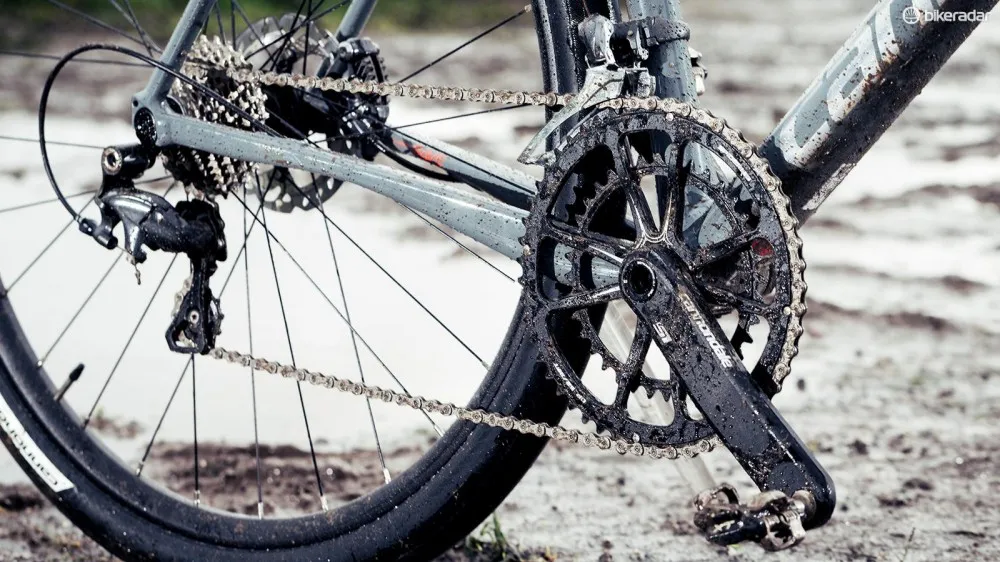We’ve always loved the fact that Cannondale isn’t afraid to take chances and push the boundaries. And it’s trying its envelope-expanding antics again, with its new and typically distinctive-looking – or dare we use the overused word ‘unique’ – Slate.
A 'road' bike with true off-road legitimacy?
Well, what’s it all about, then? According to Cannondale, it’s “A full-tilt road bike with legitimate off-road chops. Slate is the bike for cyclists that want to ride roads without having to ‘road ride’.” So, that’s told us.
Essentially it’s a bit of a mongrel – think music mash-ups or fusion food. If those examples are making you shudder, let's break it down: Cannondale has taken aggressive road bike geometry (for quick, responsive handling), 650b mountain bike wheels, massive 42mm-wide tyres and a road-specific version of its Lefty single-sided suspension fork, with extra low-speed compression damping and virtually no sag when you sit on the bike.

The Slate features Cannondale’s new road-specific Lefty Oliver fork
That single-sided fork may put people off, but bicycles are one of the few forms of transport where these aren’t the norm. Cars, trucks and even aircraft support wheel axles at one end, and if it’s good enough for landing 400 tons of Jumbo Jet, we reckon it’ll take our weight. Probably the biggest negative factor is psychological – looking down and thinking, ‘Yikes, someone’s stolen a fork leg!’
It works too. The front end doesn’t bob as you pedal as many mountain bikes do, though if you hammer into a sprint in the drops you can induce a little movement. But Cannondale has considered that…
Related: Cannondale Slate Force 1 first ride
On the top of the fork leg is a button with a secondary ring button around it. Push the middle one down and the fork locks out; press the outer ring and the suspension works as normal.
Fast-rolling but fragile fatties
We expected the big tyres to slow the Slate down on tarmac. In fact the opposite was true: run the tyres at around 45psi and they roll fast, with exceptional cornering grip.

Cannondale’s Si SpideRing crankset is paired with Shimano Ultegra gears and hydraulic disc brakes
It’s easy to hold speeds of 20mph-plus on the flat, and thanks to the smoothness of the fork and frame, with its flattened stays offering buzz-killing flex, you can maintain that pace even on the coarsest tarmac.
It manages to feel agile too, thanks to its short chainstays. The fork is more offset than on a standard road bike, so you have to be more forceful pushing into fast sharp corners, but we adjusted to its traits fairly quickly.
Off road and on gravel roads and byways the Slate comes into its own. In fact, it’s by far the quickest bike we’ve tried on the rocky, rutted surfaces of the military roads in South West England's Salisbury Plain that we regularly put bikes through the mincer on.

Riding the Slate off-road is fast and fun, but the slick TRS tyres are frustratingly fragile
The fork may have ‘only’ 30mm travel – not much compared with a modern mountain bike – but this proved sufficient to deal with large ruts and washboarded descents. The rear matches the front well, helped by features like Fabric’s comfortable Scoop saddle.
There is one major downside to the extra speed that the Slate is capable of. The TRS tyres are impressive on tarmac, but they’re correspondingly unimpressive on the rough. We can forgive the textured slick tread, since it’s so good in the dry. What we can’t forgive is the tyre’s fragility. They cut and puncture far too easily – to the extent that every time we took the Slate out, it wasn’t so much a case of if but when we’d run into trouble.
For a bike so capable, and so much fun to blast down byways, roads and tracks on, the protection offered by these tyres is a major flaw. Luckily, there are loads of other 650b options out there, from Schwalbe’s slick Kojaks (we love them, baby!) through semi-slicks to full-on knobblies. That aside, the Slate is another example of Cannondale pushing boundaries in all the right ways.



